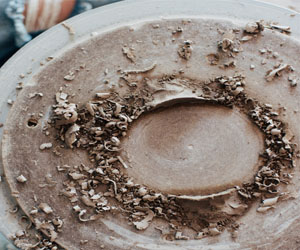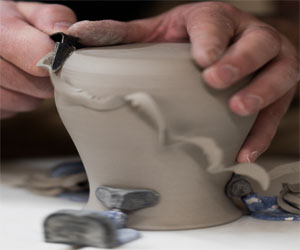


Nurturing Mind And Body

In a fast-paced, digitally driven world, finding moments of tranquility and wellness can be a challenging endeavor. The demands of our busy lives often leave little room for relaxation and self-care. However, there's an artful remedy that not only allows us to find solace in the midst of life's chaos but also promotes overall well-being - crafting.
Crafting isn't just about creating aesthetically pleasing objects; it's a gateway to holistic wellness. Whether you're knitting, painting, woodworking, or engaging in any other creative pursuit, the act of crafting offers a range of physical, mental, and emotional benefits that can significantly enhance your quality of life.
One of the most apparent benefits of crafting is stress reduction. Engaging in a creative project can provide an escape from the hustle and bustle of everyday life, allowing you to focus on the task at hand and forget about your worries for a while. This mental break can lower stress levels and promote relaxation, ultimately leading to a greater sense of well-being.
Crafting also enhances cognitive abilities. It stimulates your brain and challenges it in new and exciting ways. Whether you're following a knitting pattern or solving a design problem in woodworking, crafting requires problem-solving skills, spatial awareness, and attention to detail. Over time, these mental exercises can help sharpen your mind and keep it agile.
Furthermore, crafting encourages mindfulness. When you're deeply immersed in a creative project, you enter a state of flow, where you lose track of time and are completely absorbed in the task. This meditative quality of crafting can be profoundly calming and is akin to the practice of mindfulness meditation, which has been proven to reduce anxiety and improve mental health.
The sense of accomplishment that comes with completing a craft project can boost self-esteem and self-worth. Seeing your creations come to life can be incredibly rewarding, instilling a sense of pride and purpose. Crafting can also provide a platform for social interaction, as it is often enjoyed in groups or shared with friends and family. This sense of connection can combat loneliness and foster a sense of community, which is vital for overall well-being.
Crafting offers a physical dimension to wellness as well. Many crafts require fine motor skills, hand-eye coordination, and dexterity. For example, activities like knitting, pottery, or jewelry making engage your hands and fingers, helping to maintain their flexibility and strength. In some cases, crafting can even provide low-impact exercise, such as when you're woodworking or engaging in physically demanding hobbies like blacksmithing or glassblowing.
Crafting is more than just a creative outlet; it's a powerful tool for promoting wellness in all aspects of your life. It reduces stress, sharpens cognitive skills, fosters mindfulness, and enhances your emotional well-being. Additionally, it provides a sense of accomplishment and community. So, whether you're an experienced crafter or someone new to the world of creativity, consider picking up a craft and start reaping the rewards it can offer for your overall wellness. The act of crafting can truly nurture your mind and body, offering a sanctuary of serenity in a hectic world.




Shaping Civilizations From Clay
 Neolithic Advancements: The Neolithic period (circa 10,000 to 2,000 BCE) marked a significant leap in the history of pottery. During this time, humans developed agriculture, leading to the need for more efficient food storage and preparation. This spurred the refinement of pottery techniques and the introduction of pottery wheels for shaping clay. Various cultures worldwide, from ancient China to Mesopotamia, independently discovered pottery and ceramic techniques that would continue to evolve over the millennia.
Neolithic Advancements: The Neolithic period (circa 10,000 to 2,000 BCE) marked a significant leap in the history of pottery. During this time, humans developed agriculture, leading to the need for more efficient food storage and preparation. This spurred the refinement of pottery techniques and the introduction of pottery wheels for shaping clay. Various cultures worldwide, from ancient China to Mesopotamia, independently discovered pottery and ceramic techniques that would continue to evolve over the millennia.






The Magical Transformation Behind The Brew
 The Fermentation Process: Fermentation begins when the wort (unfermented beer) is transferred to a fermentation vessel, and yeast is introduced. The yeast starts consuming the sugars, breaking them down into alcohol, carbon dioxide, and a range of flavor compounds. During this process, the temperature and oxygen levels are carefully controlled to achieve the desired characteristics for the beer style.
The Fermentation Process: Fermentation begins when the wort (unfermented beer) is transferred to a fermentation vessel, and yeast is introduced. The yeast starts consuming the sugars, breaking them down into alcohol, carbon dioxide, and a range of flavor compounds. During this process, the temperature and oxygen levels are carefully controlled to achieve the desired characteristics for the beer style.
Primary And Secondary Fermentation: The initial fermentation, called primary fermentation, typically lasts one to two weeks. Afterward, some beer styles may undergo a secondary fermentation or conditioning phase. In secondary fermentation, the beer may be transferred to a different vessel, such as a secondary fermenter or barrels, to develop further flavors and clarity.
Flavor Development: The fermentation process is where the beer's flavor is largely determined. Yeast produces a wide variety of compounds, including alcohols, esters, and phenols, which contribute to the aroma and taste of the beer. For example, esters can impart fruity notes like banana or apple, while phenols may introduce subtle smoky or spicy characteristics.
Alcohol Production: The yeast's primary job is to convert sugars into alcohol. Ethanol, the type of alcohol found in beer, is the result of this process. The level of alcohol in the final beer depends on factors such as the type and amount of malt used and the yeast's alcohol tolerance.
Carbonation: In addition to alcohol, fermentation produces carbon dioxide, which is the source of beer's effervescence. The carbonation level can be controlled by varying factors like yeast strain, fermentation temperature, and pressure during packaging. Some beer styles are naturally carbonated, while others may undergo forced carbonation.
Achieving Consistency: Consistency in fermentation is crucial for breweries to produce the same beer batch after batch. Modern breweries employ precise temperature control and automated equipment to maintain the ideal fermentation conditions, ensuring that the beer's flavor and alcohol content remain consistent.
Savoring The Subtle Pleasures
 Smell: The olfactory sense is crucial in wine tasting. Swirl the wine gently in your glass to release its aromas and then take a moment to inhale. Note the wine's bouquet, identifying various scents like fruit, flowers, spices, or oak. The aroma can provide insights into the wine's age, origin, and quality.
Smell: The olfactory sense is crucial in wine tasting. Swirl the wine gently in your glass to release its aromas and then take a moment to inhale. Note the wine's bouquet, identifying various scents like fruit, flowers, spices, or oak. The aroma can provide insights into the wine's age, origin, and quality.
Taste: This is the heart of the wine tasting experience. Start with a small sip, allowing the wine to coat your palate. Assess the wine's flavors, acidity, sweetness, and tannins. Look for complex layers of taste, from the initial impression to the finish. Consider the balance and harmony of the wine's components.
Touch: The tactile sensation of wine is an often-overlooked aspect. Assess the wine's body or weight on the palate. Is it light, medium, or full-bodied? The texture should be smooth and pleasing, with the right level of astringency from tannins.
Sound: While it might not be as prominent, the sound of wine plays a role in the overall experience. When you slurp the wine, the sound can provide clues about its viscosity and body. Experienced tasters often make a slight slurping sound to aerate the wine as it passes through their palate.
The Art Of The Swirl And Sip: The gentle swirl of the wine in the glass releases its aromas, allowing you to take in the full bouquet. This practice aerates the wine, which can enhance the aromas and flavors.
Taking small sips and holding the wine in your mouth allows for a thorough evaluation of its taste and texture. The art of wine tasting involves paying attention to the wine's complexity, noting the interplay of fruit, acidity, and tannins.
The Art Of Terroir: Terroir, the unique combination of soil, climate, and geography of a specific wine region, is a fundamental concept in wine tasting.
The Beauty Of Green Handmade Goods
 Artistic Innovation Meets Sustainability
Artistic Innovation Meets Sustainability
Green handmade goods are a testament to the union of creativity and environmental responsibility. Crafters and artisans across the globe are channeling their talents to produce items that not only serve a functional or decorative purpose but also adhere to eco-friendly principles. These goods are often made using natural or repurposed materials, creating a harmonious blend of artistry and sustainability.
Supporting Local Economies
One of the significant advantages of green handmade goods is their role in supporting local economies. Artisans and crafters, often small-scale businesses or individuals, contribute to their communities by crafting unique items. This helps strengthen local economies and reduces the carbon footprint associated with mass-produced, globally distributed products.
A Reduction In Waste
The process of creating green handmade goods encourages a reduction in waste. Many artisans rely on repurposed or upcycled materials, diverting items that might have otherwise ended up in landfills. The upcycling trend, in particular, is a testament to the innovative and sustainable approach taken by crafters.
Customization And Personalization
Green handmade goods offer a level of customization and personalization that is often lacking in mass-produced items. Artisans can tailor their creations to meet the unique needs and preferences of their customers. This not only reduces overconsumption but also fosters a deeper connection between the product and its owner.
Creating Art From Earth
 2. Stress Relief: Working with clay has a therapeutic effect. The tactile experience of manipulating the cool, moist material, combined with the meditative process of shaping, pinching, and molding, can help alleviate stress and promote mindfulness. As you immerse yourself in the creative process, daily concerns tend to fade away.
2. Stress Relief: Working with clay has a therapeutic effect. The tactile experience of manipulating the cool, moist material, combined with the meditative process of shaping, pinching, and molding, can help alleviate stress and promote mindfulness. As you immerse yourself in the creative process, daily concerns tend to fade away.
3. Sense Of Accomplishment: Completing a pottery project can be immensely rewarding. The tangible nature of the craft allows hobbyists to see the fruits of their labor take shape before their eyes. Whether it's the first pinch pot or a finely glazed vase, the sense of accomplishment is empowering and boosts self-esteem.
4. Functional And Decorative Items: Pottery offers a practical aspect as well. Hobbyists can create personalized, one-of-a-kind items for everyday use, such as plates, bowls, and utensils. These functional pieces can add a special touch to your home while showcasing your craftsmanship. Alternatively, pottery can be used to craft decorative items, making your living space uniquely beautiful.
5. Continuous Learning: Pottery is a hobby that offers endless opportunities for learning and growth. From mastering basic techniques like coiling, slab-building, and wheel-throwing to experimenting with glazes, there's always something new to discover. Experienced potters can push their boundaries by exploring advanced methods and complex forms.
Exploring The Benefits
 Medicinal Properties
Medicinal Properties
Herbs have been used for centuries as natural remedies for a wide range of ailments. Lavender is renowned for its calming and soothing properties, chamomile for its digestive benefits, and peppermint for its ability to alleviate headaches. Growing these herbs allows you to harness their medicinal powers for home remedies and holistic wellness.
Aromatherapy
The fragrant oils found in herbs are not just for flavor and aroma. They also have therapeutic qualities. Lavender, for instance, is widely used in aromatherapy to promote relaxation and reduce stress. Aromatic herbs can transform your garden into an outdoor sanctuary for your senses.
Environmental Benefits
Herb gardens contribute to a more sustainable and eco-friendly lifestyle. By growing your herbs, you reduce the demand for commercially cultivated, chemically treated herbs. This practice conserves resources and minimizes the environmental impact of herb production.
Cost-Effective
Maintaining an herb garden can save you money in the long run. Store-bought herbs can be expensive, and they often come in quantities larger than you need, leading to waste. By growing your herbs, you can have a fresh supply on hand while minimizing expenses.
Educational Value
Herb gardening offers a valuable learning experience. It can be an engaging and educational hobby for individuals and families alike. Gardening teaches responsibility, patience, and an appreciation for the natural world. It allows you to connect with the earth and understand the cycles of growth and renewal.
Aesthetic Pleasure
Herb gardens are not just practical; they are also beautiful. The lush green foliage, colorful blossoms, and fragrant aromas create a visually appealing and soothing garden space. Herbs can be integrated into ornamental garden designs, adding both utility and charm.